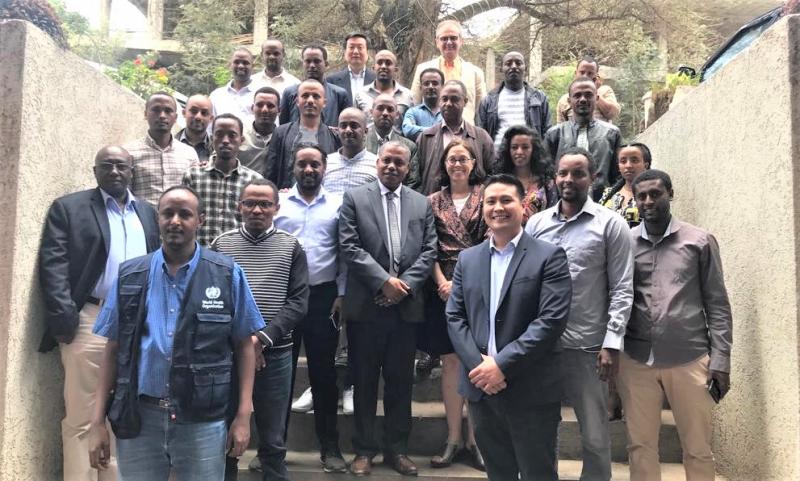
Milestone Ethiopia Exercise Boosts Preparedness, Links National and Disease-Specific Plans
April 11, 2019
African Region
Ethiopia
Ethiopia
CHAMPIONING ETHIOPIA’S NATIONAL PLANS
ALIGNMENT AND HARMONIZATION OF ETHIOPIA’S NATIONAL ACTION PLAN FOR HEALTH SECURITY WITH THE EBOLA PREPAREDNESS PLAN AND PANDEMIC INFLUENZA PREPAREDNESS PLAN
From 11th to 16th April 2019, at the request of the government of Ethiopia, WHO organized the Consultative Workshop to Update and Link Pandemic Influenza and Ebola Viral Disease Preparedness with the National Action Plan for Health Security (NAPHS).The landmark exercise resulted in Ethiopia becoming the first country in the world to link its NAPHS with disease-specific plans.
The workshop, convened by the Ethiopian Public Health Institute (EPHI) in collaboration with WHO, also led to Ethiopia becoming the first country in Africa to develop its pandemic influenza preparedness plan using the latest WHO checklist for pandemic influenza risk and impact management (PIRM). The checklist highlights important actions and capacity requirements that countries should consider.
The workshop was a direct follow up to WHO Strategic Partnership for IHR and Health Security (SPH) support for a 13-14 March resource mapping exercise in Ethiopia, and to the 15 March launch of Ethiopia’s NAPHS with endorsement of H.E Deputy Prime Minister Demeke Mekonnen.
The linkage of Ethiopia’s NAPHS with its pandemic influenza and Ebola preparedness plans increases efficiency, avoids duplication of activities, and facilitates the effective mobilization of resources, allowing disease-specific funding to be leveraged for NAPHS implementation and the building and maintaining of long-term and sustainable capacities under the International Health Regulations (IHR, 2005). Linking the actions and activities in the different plans creates synergies, aligns priorities and fosters country ownership of health emergency preparedness and disease management.
The exercise in Bishoftu, Ethiopia, involved group work using the WHO SPH resource mapping tool to make connections between the plans and foster alignment. For example, Ethiopia’s NAPHS calls for establishment of Emergency Operations Centers (EOCs) in all regions. EOCs are also proposed in the influenza and Ebola preparedness plans. An EOC does not have to be disease-specific and can be adapted for different health emergencies; linking the plans avoids duplication of establishing EOCs for each disease. Another example is management of personal protective equipment (PPE). PPE for Ebola and influenza are different but the stockpile management can be a shared capacity.
The impact of such linkages goes beyond Ebola and pandemic influenza to also include preparedness for other haemorrhagic fevers and Severe Acute Respiratory Infections (SARI). The Ebola plan represents a model for building broader preparedness for all haemorrhagic fevers, including Marburg, Lassa fever and yellow fever. Similarly, pandemic influenza preparedness is a model for seasonal influenza and SARI. Preparedness for pandemic influenza requires capacities with broad applicability, such as having in place effective vaccine deployment plans, procedures and policies.
The WHO Ebola Virus Disease (EVD) checklist was used to update the Ethiopia EVD Preparedness Plan during the workshop, which identified over 50 EVD preparedness activities to link to the NAPHS. The linkage provides the added benefit of helping to ensure the five-year NAPHS remains a living document, directly connected to Ethopia’s efforts to protect its population from Ebola.
The WHO pandemic capacity progress indicator (PCPI) tool was piloted in the workshop for successful development of Ethiopia’s draft pandemic influenza preparedness plan. WHO SPH developed the PCPI tool to support countries in creating or revising their pandemic influenza plans with the guidance of the WHO checklist for pandemic influenza risk and impact management.
The PCPI tool synthesizes the checklist with the country’s scores from its Joint External Evaluation (JEE), enabling analysis of how much progress the country has already made in pandemic influenza preparedness and where the needs and gaps exist. The PCPI tool will continue to be piloted in countries over the next year to allow for full development and implementation.
At the time of the Ethiopia workshop, EPHI activated its Public Health Emergency Operations Center (PHEOC) for an acute health emergency of internally displaced people and requested that the response plan be linked to the NAPHS as well. This was accomplished by the EPHI team in a half day using the resource mapping tool and presented to donors on the final day. This demonstrated the ease and flexibility of the resource mapping tool which enriches and integrates the planning needs of the country.
Uganda has submitted a request for similar WHO support as provided in Ethiopia, including WHO SPH support in use of the PCPI and resource estimation tools, and a workshop will be scheduled there soon.
The linkages made in the Ethiopia workshop between NAPHS and specific health emergency plans are aimed at strengthening the health system through developing sustainable health security capacities. Building resilient and responsive health systems is critical to achieving health security, progressing towards universal health coverage (UHC), and achieving the Sustainable Development Goals (SDGs).